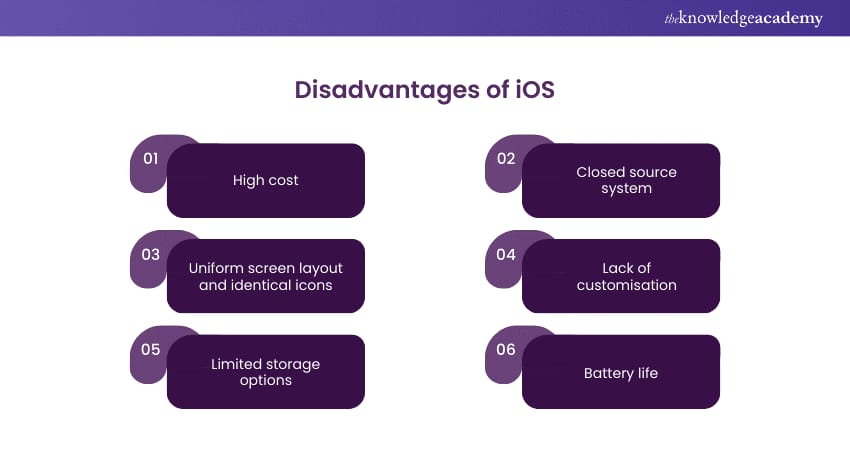Disadvantages of the Apple iPhone are intended to refer to various limitations, drawbacks, or weaknesses related to iPhone use compared to other smartphones. Its disadvantages include the exorbitant cost of acquisition, the low availability of customization possibilities, and the lack of expandable storage. iPhones are generally blamed for relying on Apple’s in-house ecosystem, reducing the level of compatibility with non-optimized hardware and peripherals. Users also face battery life, lack of headphone ports in new devices, and minimal design innovation from one generation to the next. Apple has also set strict App Store policies that limit user freedom. All of these combined represent the constraints of the iPhone.
1.Expensive price
Apple iPhones are widely known for their premium price range. Even the base model starts at a much higher price than many powerful Android phones. While Apple justifies costs by tackling quality, ecosystem, and brand value, many consumers get unfair prices, especially when similar features are available in more affordable options. Costs also decrease, including accessories, Applecare, and memory upgrades. In many countries, especially developing countries, the iPhone is considered a luxury item rather than a practical smartphone. This pricing strategy limits access to a significant portion of users.
2. There is no expandable space
iPhone storage does not offer microSD card support for expansion. Whatever you buy, you get it. If you run out of space, you’ll need to rely on cloud storage (including its own limitations and costs) or delete files. Unlike many Android phones where simple memory cards can solve memory problems, iPhone users should either always manage their memory from the start or buy a model with more capacity. This limitation is especially unrealistic for users who store multiple videos, photos, or apps.
3. Do not change battery frequently
Repeated iPhone battery breakdown makes it difficult for users to replace the battery. Over time, lithium-ion batteries deteriorate and their price decreases. Apple offers battery replacement services, but this is expensive and time consuming. Conversely, some Android phones make it easier to provide user-resistant batteries or replace them with services from third-party providers. This can be a major inconvenience for people in the area who do not have easy access to the permitted service centres. Non-adventure design also contributes to e-waste, as people often replace the entire phone, not the battery.
4. No USB-C connection (for many models)
Most iPhones in the iPhone 14 series use the Apple-owned Lightning port and are not the widespread USB-C standard. This means that some cables are required for charging and data transmission, especially when carrying or switching the device. USB-C is fast for loading and sending data and is standard for most other devices such as laptops, Android phones, tablets, and others. The slow deployment of Apple’s USB-C creates inconvenience and contributes to e-waste as users store many types of cables.
5. Limited customization
The iPhone runs on iOS, which is known for its cleanliness and uniformity, but is also extremely limited from the point of view of customization. Unlike Android, where users can change themes, symbols, launchers, and even custom ROMs, iOS only offers very limited options. You can reorganize app symbols and change the background image, but that’s it. Even widgets introduced later in iOS are less flexible than Android. This lack of personalization can lead to a user experience that is stable and repetitive, especially for technically experienced users who are ready to adapt your device to your needs and preferences.
6. Unique ecosystem lock-in
The Apple ecosystem is designed to work seamlessly with other Apple products such as MacBooks, iPads, AirPods, and Apple Watch. This integration creates a form of lock-in that makes it more comfortable and makes it difficult for users to switch to non-Apple products. If you’re investing in Apple services or accessories, switching to an Android phone or Windows laptop can be annoying and expensive. This ecosystem block-in benefits Apple, but it limits consumer choices. This is one of the main reasons why users feel “trapped” when they start using their Apple device.
7. No headphone jack
Apple removed the 3.5mm headphone bushing starting with the iPhone 7 and pushed the user with a wireless headphone or dongle. The move is controversial and while many other brands have followed the example, it remains disadvantageous for users who prefer wired headphones to improve sound quality or avoid delays. If you use a dongle, you will have to wear and lose the object. It also prevents charging and listening at the same time, unless you purchase an additional adapter. Wireless audio has been improved, but the convenience and reliability of the headphone socket has not been met.
8. Options with limited file transmission
Transferring files between your iPhone and your computer or other device is not as easy as Android. In many types of cases, you need iTunes or Finder that syncs or depends on Airdrop, which only works in the Apple ecosystem. USB files are only sent in limited quantities, and the file system is not easily accessible to users. Android phones, on the other hand, can enable drag and drop transfers and assemble as external drives. This limitation affects productivity, especially for users who have to transfer large files or work in a cross-platform environment.
9. Expensive goods
Apple’s goods such as charging cables, adapters, and headphones are much more expensive than those from third-party manufacturers. Even simple items like replacement chargers can cost Apple a lot to buy. Additionally, Apple limits the performance of unauthenticated accessories and obliges users to purchase “MFI” authenticated “iPhone” (MFI). This limit increases the total operating cost. Although accessories are commonly used, pricing strategies are considered exploitative by many users.
10. Charging speed is slow
The iPhone supports slower charging speeds than many flagship Android phones. The Android brand currently offers fast charging solutions up to 100 W or more, but iPhones typically range from 20 to 27 W. This means it takes time for your iPhone to fully charge. This can be frustrating for users who are on the go all the time. Apple has made some improvements with its latest models, but it still lags behind the competition. The situation is made worse by the fact that Apple does not include chargers in boxes that users have to purchase separately to reach maximum load speeds.
11. Restrictive App Store Guidelines
Apple has very close control over the App Store, which allows developers to offer stricter rules and higher prices. This generally leads to a safer environment, but also limits user freedom. Services such as developers and some apps are either restricted or postponed due to Apple guidelines. For example, games – streaming platforms and emulators face obstacles. Developers have to pay a 15-30% fee for in-app purchases that are often sent to customers. Customers are also unable to download apps outside the App Store without jailbreaking. This may affect your warranty and security.
12. No default app options (limited)
Apple did not allow users to install iOS 14 as a default configuration app, such as a browser and email application. Although some flexibility has been introduced, the options are not very wide. For example, Safari and Apple Mail are deeply embedded in the system. Even if you set options like Chrome or Mail Mail as default, system-level capabilities can be toggled in the Apple app. It is different from Android, which allows individuals to change the default apps and services seamlessly. The lack of complete freedom through simple apps can be frustrating for those who prefer the option.
13. Insufficient cross-platform compatibility
Apple’s services, such as iMessage, FaceTime, and Airdrop, work beautifully in the Apple world, but are limited or not available for non-Apple devices. This makes it difficult to communicate or share files with your Android phone or Windows PC. Group communication between Android and iPhone users usually leads to a decline in performance and media quality. While customer experience matters most within Apple, this strategy excludes individuals who have to exchange with each other. It is devoid of open standards, reducing the sense of flexibility and forcing consumers to stay in Apple’s closed classes.
14. There is no reverse wireless shop
Most Android phones currently offer reverse wireless channels, in which users can charge accessories like earphones and other phones on the back of their phones. This is especially convenient during emergencies. But the iPhone hasn’t offered this feature yet. There are some models that have hardware but this feature is discontinued. This is to the disadvantage of those who invest in wireless accessories, especially those who invest in iPhone, especially those who invest in wireless accessories. In the absence of a reverse wireless store, the iPhone appears to lag behind compared to Android objects.
15. iCloud storage is limited to free users
Apple only offers 5 GB of free iCloud storage. This is not enough for most users, especially those who want to store photos, videos, and app data. Users will be obliged to delete data or subscribe as soon as memory runs out. Google offers 15 GB free and free, offered through Google Mail, Google Drive and Photos. Limited free memory makes your iPhone experience seamless and creates hidden costs. This is particularly disturbing considering the cost of the device. People want to get more in return for what they pay.
16. Delicate design
iPhone design beautiful but delicate, often made of glass both front and back. It looks high quality and makes your phone very vulnerable to cracks and damage. iPhone repairs, especially back glass, are expensive. Users often need to use extra shells and screen guards. Design weaknesses lead to reckless use and increase maintenance costs. Compared to some rugged Android phones, iPhone isn’t ideal for users who want to request an environment or drop the phone.
17. Constant software updates are actively installed
Apple regularly sends software updates to your iPhone, which is generally a good thing. However, these updates are often installed without giving users too many options, especially when automatic updates are activated. Some updates could put changes users don’t like, or reduce battery performance on older models. There was controversy Apple slowed old iPhone through update to maintain battery life. It reduces users’ trust and control of their device.
18. No split screen multitasking on small models
Unlike many Android devices that support split screen multitasking, the iPhone (especially non-pro and non-plus models) does not have this feature. Users who want to use two apps at the same time, such as video when responding to messages, can do so unless they use an iPad or a specific model. This limits productivity and convenience. Many Android phones have supported this feature for years on medium-range models. Apple isn’t ready to bring an iPhone with split screen multitasking, it seems like an unnecessary limitation.
19. It does not always remain on display on older models
Always on Display (AOD) is a function that allows users to view time, notifications, and other information without waking up the phone. This feature is available on many Android phones and is anticipated for its convenience and battery efficiency. However, only the latest iPhone Pro models offer AOD, and older models are completely missing. This makes a big difference in the user experience. Users should wake up the phone or use a raise to check time and notifications, which is less efficient.
20. Limited AI and intelligent features
The iPhone is powerful, but lags behind some Android competitors in terms of AI and intelligent features. For example, Google Assistant is generally more intelligent than Siri in its treatment of complex questions. Features such as automatic call screening, live transcription, and real-time translation are more advanced and slightly available on Android phones. iPhones often miss out on these innovations or take them over later. Users looking for the latest smart features may be short of an iPhone.
21. Slow innovation
Apple is known for its conservatism with new technologies. Features such as a high refresh rate display, periscope zoom, and fingerprint sensor in the display either come late or are still missing from the iPhone. Meanwhile, Android manufacturers often experiment with new features. This careful approach means that iPhone users often receive less exciting innovations and, when coming, are classified as innovative despite having existed elsewhere for years.
22. Expensive repair costs
iPhone repair is much more expensive than most other smartphones. Even minor repairs, such as broken screens and battery replacements, can be expensive if they are done through Apple. Repairs from third-party providers may reduce the performance guarantee of software limitations or reduce performance. A tightly controlled repair ecosystem and Apple’s high service costs prevent users from repairing their phones immediately, and often force upgrades.
23. In some markets, there is no real double shim support
The new iPhone is dual SIM support (including ESIM), but many models in all regions do not support true dual-SIM features. This is often to the disadvantage of users who want to set aside travel, work or personal numbers. Android phones have long offered flexible double SIM options, including dual standby and independent SIM management. Apple’s partial implementations can be restrictive and frustrating.
24. Heavy reliance on iTunes/Finder for backup
You need iTunes (Windows) or Finder (MacOS) to pin your iPhone to your computer. These platforms are gradually becoming problematic, not the users. iCloud is optional, but has limited free space. Android phones, on the other hand, enable simple security options via Google Drive or third-party tools. Dependence on outdated software for backup is an obvious drawback for iPhone users.
25. Limited freedom of development
Apple’s iOS prevents developers from accessing certain features at the system level. This limits the functionality of the app compared to what is possible on Android. For example, an app can record calls, change system settings, and provide real background functions. It improves safety and battery life, limits innovation and flexibility. Developers are often restricted and eventually the variety and features of the app are available to users.
Read Also:
- Advantages Of Apple Iphones
- Iphone 17 Pro May Come With 48-Megapixel Telephoto Camera Lens, Rumors New Leak
- Whatsapp Can Be Made The Default Calling And Messaging App: International Calling Without Extra Charge, Available For Iphone Users In The Beta Version Of The App
- Apple iOS 18.4 New Release Date: Sweeping iPhone Update Drops Anytime Now
- Apple Iphone 16e Has AI Features: Apple Most Advanced C1 Modem Till Date, No Tension Of Battery Backup
- Pixel 9a vs iPhone 16E: Buy It In 2025 Year?
- Introduction About Apple iPhone 16 Pro
- Apple First Foldable iPhone Could Cost As High As $2500
- Apple Foldable iPhone Plans: Everything We Know So Far On Whether The Rumours Are True Or Not
- Corporate Success Factors of Apple iPhone Company
- Analysis of Success Consumer Factors of Apple’s iphones
- What Types Of Factors Contributed To The Success of Apple iPhone Company
- History Of Zamzam Electronics
- Samsung Galaxy M56 Smartphone Features
- Smart Phones: Universal Mobile Terminals
- POCO C71 Budget Phone With 5200mah Battery Up For Sale: Price, Specifications
- Existing Products Of Apple






